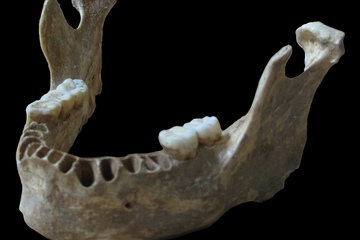Geneticists have analyzed ancient DNA from an old jawbone and concluded that it belonged to a modern human whose recent ancestors included Neanderthals. Archaeologists found the jawbone—attributed to a European about 40,000 years ago—in Romania in 2002.
Geneticists have analyzed ancient DNA from an old jawbone and concluded that it belonged to a modern human whose recent ancestors included Neanderthals.
Archaeologists found the jawbone—attributed to a European about 40,000 years ago—in Romania in 2002.
The person may have had a Neanderthal ancestor as recently as four to six generations back, and it shows that mixing between modern humans and Neanderthals occurred soon after anatomically modern humans arrived in Europe, scientists claim.
Neanderthals lived in Europe until about 35,000 years ago, disappearing just as modern humans spread across the continent. The new study, co-led by David Reich of Harvard Medical School and Svante Pääbo at the Max Planck Institute in Germany, is reported in the June 22 issue of the journal Nature.
“Before 45,000 years ago, the only humans in Europe were Neanderthals. After 35,000 years ago, the only humans in Europe were modern humans. This is a dramatic transition,” Reich said.
There is archaeological evidence that modern humans interacted with Neanderthals, he added: Changes in tool making technology, burial rituals, and body decoration imply a cultural exchange. “But we have very few skeletons from this period,” Reich said.
The jawbone is “amazing,” Reich said. It was found along with the skull of another person in a cave called Oase. No artifacts turned up nearby. The jawbone’s features were predominantly those of modern humans, but some Neanderthal traits were also apparent, and the anthropologists proposed a recently mixed ancestry.
Pääbo and Reich teamed up to analyze its DNA. Trace amounts of ancient DNA can be recovered from bones as old as the Oase jawbone, but to analyze it, that ancient DNA must be sifted out of an overwhelming amount of DNA from other organisms. When Qiaomei Fu, who was a graduate student in Pääbo’s lab, obtained DNA from the bone, most of it was from microbes that lived in the soil where the bone was found. Of the fraction of a percent that was human DNA, most had been introduced by people who handled the bone after its discovery.
Using methods pioneered in Pääbo’s lab, Fu enriched the proportion of human DNA in the sample, using genetic probes to retrieve pieces of DNA that spanned any of 3.7 million positions in the human genome that are considered useful in evaluating variation between human populations.
Most of the DNA she ended up with was human, but came from people who had handled the jawbone since 2002, rather than the jawbone itself. Fu, who is now a postdoctoral researcher in Reich’s group, solved that problem by restricting her analysis to DNA with a kind of damage that deteriorates the molecule over tens of thousands of years.
Once they had discarded contaminating DNA, Reich’s team could compare the fossil’s genome to genetic data from other groups. Through a series of statistical analyses, a surprising conclusion emerged. “The sample is more closely related to Neanderthals than any other modern human we’ve ever looked at before,” Reich said. “We estimate that six to nine percent of its genome is from Neanderthals. This is an unprecedented amount. Europeans and East Asians today have more like two percent.”
Reich said he found segments of intact Neanderthal DNA large enough to point to the recent ancestry. “In the last few years, we’ve documented interbreeding between Neanderthals and modern humans, but we never thought we’d be so lucky to find someone so close to that event,” he said.
But the Oase person isn’t responsible for passing his Neanderthal ancestry on to present day humans, he said, as there is no evidence this individual is closely related to later Europeans.
“This sample, despite being in Romania, doesn’t yet look like Europeans today,” he said. “It is evidence of an initial modern human occupation of Europe that didn’t give rise to the later population. There may have been a pioneering group of modern humans that got to Europe, but was later replaced by other groups.”










